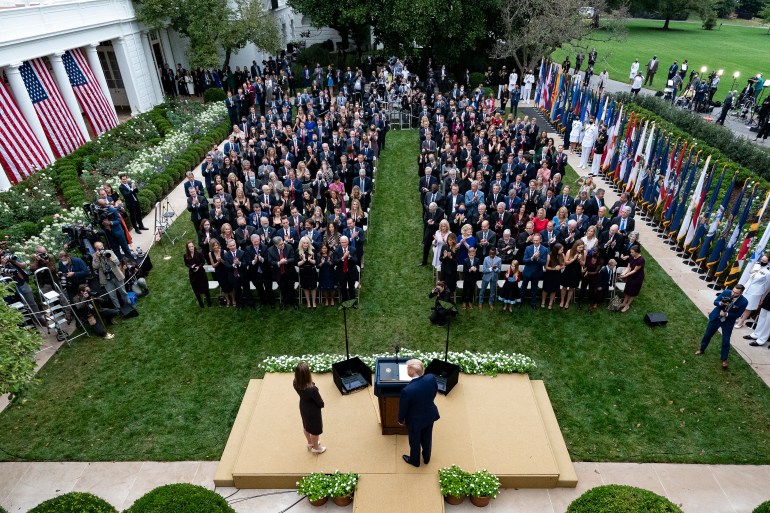How Donald Trump’s COVID-19 illness unfolded: A timeline
What we know, and do not know, about President Donald Trump’s bout with COVID-19 after he tested positive on October 1.
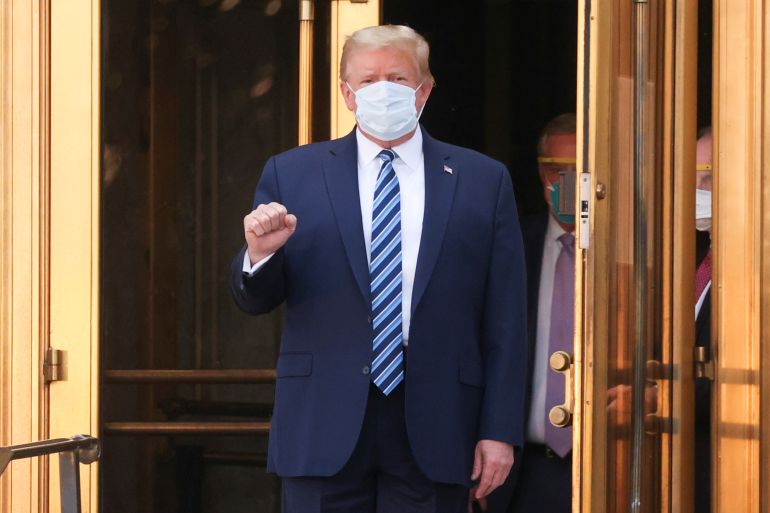
United States President Donald Trump revealed in the early hours of October 2 that he had tested positive for COVID-19. White House officials and doctors have refused to disclose when the president last tested negative for the coronavirus before the positive test.
It remains unclear how and where Trump may have contracted the virus and how long he had symptoms.
Keep reading
list of 4 itemsFull jury panel seated on third day of Trump’s New York hush-money trial
Seven jurors seated on the second day of Trump’s New York hush-money trial
Six takeaways from first day of Trump’s New York hush money criminal trial
The president was admitted to Walter Reed National Medical Center on the evening of October 2 after White House physician Dr Sean Conley and chief of staff Mark Meadows became alarmed by his condition. Conley said the president had a fever from Thursday into Friday.
President Trump was forced to suspend his re-election campaign travel and rallies during his three-night stay at the Walter Reed hospital before returning to the White House on October 5.
Dr Conley and the president’s medical team have given daily briefings or issued statements to the news media describing Trump’s COVID-19 symptoms as relatively mild. They have said the president is being treated with remdesivir, an antiviral medication, and dexamethasone, a powerful anti-inflammatory steroid that is typically used on patients with serious COVID-19 symptoms.
Trump was initially given a dose of the experimental antibody cocktail Regeneron before leaving the White House. The president required supplemental oxygen on two occasions on October 2 and 3, the doctors said.
Doctors have declined to provide specifics on any damage or pneumonia in the president’s lungs.
More than two dozen of Trump’s close aides, political allies and White House staff have now tested positive for COVID-19 in the outbreak.
Days seven to 10 of the disease would be critical in how the disease progresses, Dr Conley had said.
Here is a timeline of events:
October 9, 20:20 ET – Trump says he’s feeling ‘strong’
In a taped appearance on Fox News television, President Donald Trump said he is feeling “strong” after his bout with COVID-19.
The president again credited an infusion of the experimental Regeneron antibody cocktail for his rapid recovery from the deadly virus.
When asked about his symptoms when he first became sick, Trump was vague, saying he “didn’t feel strong … I didn’t feel how the president of the United States should feel.”
Trump acknowledged that lung scans showed he “initially had some congestion in there” which he said was one reason “why they wanted me to stay” in the hospital longer.
Trump said he thinks catching the virus “early was a big factor”. He said he is being tested regularly to assess whether he still has the virus.
October 8, 19:00 ET – Trump clear to return to campaign as soon as Saturday: White House physician
President Trump’s physician Dr. Sean Conley released a statement through the White House communications office saying Trump has continued to “respond extremely well to treatment, without evidence on examination of adverse therapeutic effects.”
“Saturday will be Day 10 since Thursday’s diagnosis, and based on the trajectory of advanced diagnostics the team has been conducting, I fully anticipate the president’s safe return to public engagements at that time.”
Trump returned to work in the Oval Office for a second consecutive day.
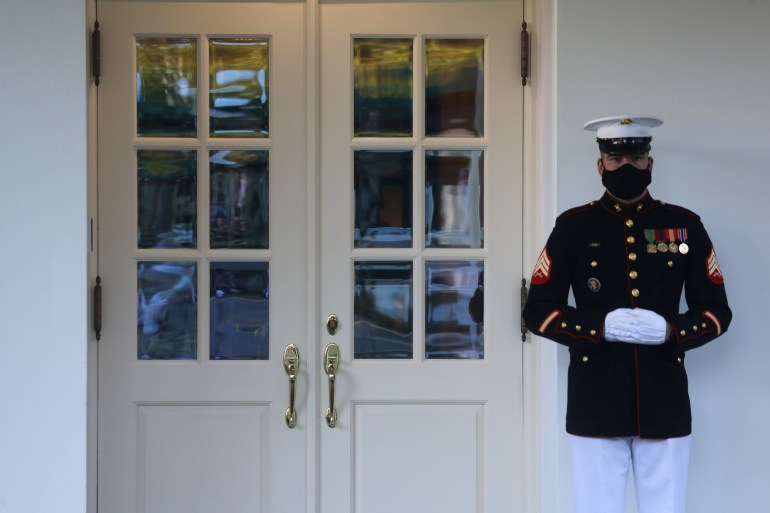
October 7, 13:15 ET – White House physician says Trump feels ‘great!’
Trump’s physician Dr Sean Conley said in a statement released by the White House communications office that the president has been “fever-free for more than four days, symptom-free for over 24 hours, and has not needed nor received any supplemental oxygen since initial hospitalization”. Blood tests show Trump has COVID-19 antibodies, indicating he has developed an immune response to the virus. “The president this morning says, ‘I feel great!’,” Conley said.
October 6, 21:18 ET – White House aides worry about Trump’s ‘cocktail of drugs’ amid tweet storm; Trump was not tested daily prior to Friday: Report
Some White House staff members wondered whether President Trump’s storm of more than 40 tweets – including one cancelling talks on virus relief spending legislation – was spurred by a cocktail of drugs he has been taking, the New York Times newspaper reported.
Trump was to have received a fifth and final dose of remdesivir, an antiviral drug, on Tuesday and had been taking dexamethasone, an anti-inflammation steroid that can cause euphoria and bursts of false energy.
White House officials conceded that prior to Trump testing positive for COVID-19 there had been a false impression created that the president was getting tested daily and a reliance on testing as if it were a curative measure as opposed to a diagnostic, the newspaper reported.
The president was not tested every day, according to two people familiar with the practices, according to the report.
October 6, 12:50 ET – White House says doctors met with Trump and the president reports no COVID-19 symptoms
Dr Sean Conley, Trump’s physician, said the president “reports no symptoms” of COVID-19 and that his vital signs are stable.
“Overall, he continues to do extremely well,” Dr Conley said in a statement.
Dr Conley and the White House refused to clarify what the “expected findings” were when asked about Trump’s chest x-rays at Walter Reed over the weekend, according to news reports.
October 5 – Trump stages return to White House and promises in a tweet to return to campaigning
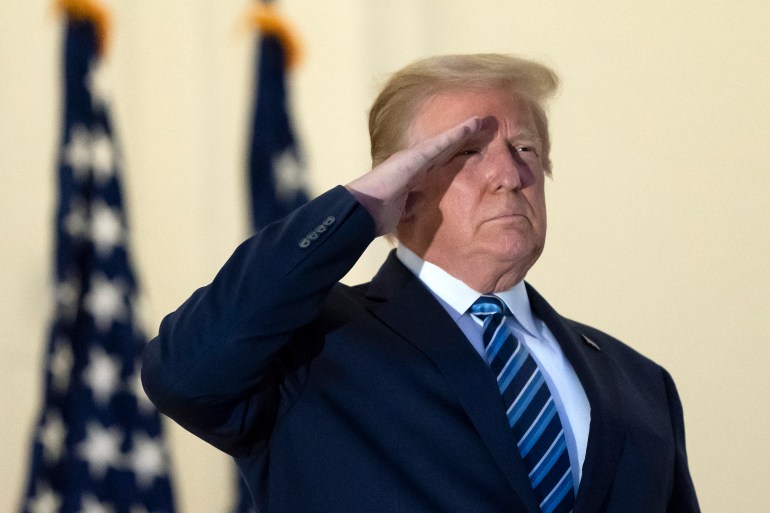
Will be back on the Campaign Trail soon!!! The Fake News only shows the Fake Polls.
— Donald J. Trump (@realDonaldTrump) October 5, 2020
October 5 – Trump announces on Twitter he will be leaving the Walter Reed hospital
I will be leaving the great Walter Reed Medical Center today at 6:30 P.M. Feeling really good! Don’t be afraid of Covid. Don’t let it dominate your life. We have developed, under the Trump Administration, some really great drugs & knowledge. I feel better than I did 20 years ago!
— Donald J. Trump (@realDonaldTrump) October 5, 2020
October 5, 11:20 ET Dr Sean Conley briefs media on Trump’s condition: ‘Not out of the woods yet’
“Over the past 24 hours, the president has continued to improve. He’s met or exceeded all standard hospital discharge criteria. He’ll receive another dose of remdesivir here today, and then we plan to get him home. It’s been more than 72 hours since his last fever, oxygen levels, including ambulatory saturations and his work of breathing are all normal,” Dr Sean Conley told the media.
“Though he may not entirely be out of the woods yet, the team and I agree that all our evaluations, and most importantly his clinical status, support the president’s safe return home where he’ll be surrounded by world-class medical care,” Dr Conley said.

Regarding the decision to give Trump dexamethasone, Conley said it was reached on October 4 after consultation among the president’s medical team.
“Yesterday, we talked about that, the several little temporary drops in his oxygen, and we had discussed that as a team and elected to start it early in case that persisted or worsened. The potential risks and side effects, we all discussed. We looked at the data and decided that we’d rather push ahead on it than hold and risk the opposite,” Conley said.
Conley declined to say whether Trump had any pneumonia or inflammation in the lungs.
Trump had used oxygen in “two episodes” and “recovered immediately”, Conley said.
October 4 – Trump greets supporters outside hospital from a motorcade drive-by
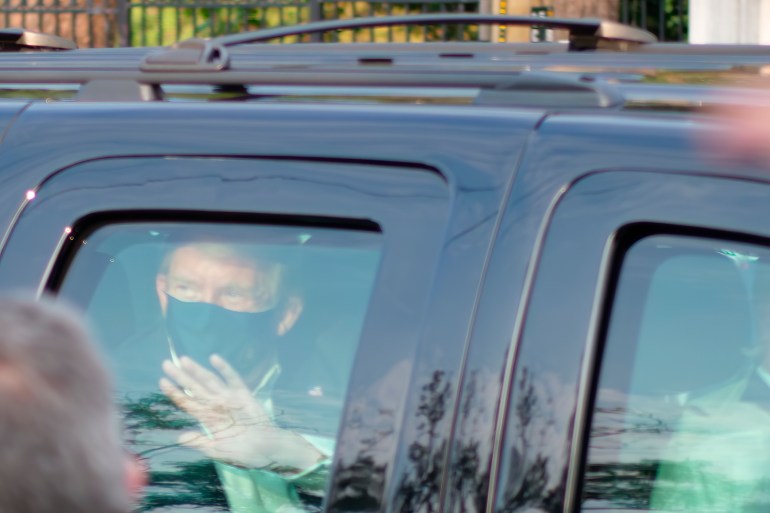
October 4, 18:56 ET – Trump tweets video saying he “learned a lot about COVID”
“I learned it by really going to school. And this is the real school. This isn’t the let’s read the book school. And I get it and I understand it. And it’s a very interesting thing. And I am going to be letting you know about it,” Trump said.
— Donald J. Trump (@realDonaldTrump) October 4, 2020
October 4, 18:51 ET – Trump tweets thank you to supporters gathered outside Walter Reed
I really appreciate all of the fans and supporters outside of the hospital. The fact is, they really love our Country and are seeing how we are MAKING IT GREATER THAN EVER BEFORE!
— Donald J. Trump (@realDonaldTrump) October 4, 2020
October 4, 11:40 ET – Trump’s condition worse than previously acknowledged, but president doing ‘really well’
Dr Sean Conley tells media at Walter Reed the president had run a high fever on October 2 and had been given supplemental oxygen after his blood saturation levels dropped.
In response to the low-oxygen episodes, Conley said the president was being treated with dexamethasone, an anti-inflammatory steroid that outside experts said is more often used in advanced cases of COVID-19 and not recommended for early treatment.
Asked if Trump had signs of lung damage, Conley said, “there’s some expected findings, but nothing of any major clinical concern”.
“The fact of the matter is, is that he’s doing really well. He is responding. As the team said, if everything continues to go well, we’re going to start discharge planning back to the White House,” Conley said.
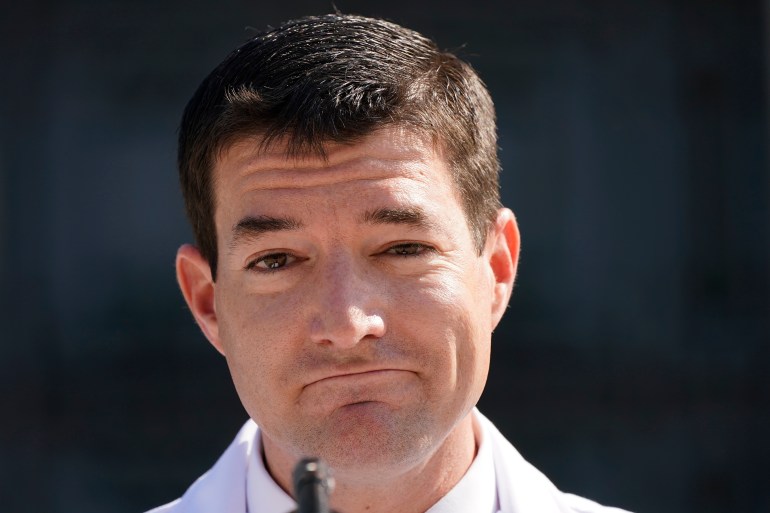
October 3, 21:20 ET – Dr Sean Conley issues evening update saying Trump has ‘made substantial progress’.
“He remains fever free and off supplemental oxygen with a saturation level between 96 and 98 percent all day,” Conley said in a statement issued through the White House communications office.
“He spent most of the afternoon conducting business, and has been up and moving about the medical suite without difficulty,” Conley said.
October 3, 18:51 ET – Trump tweets ‘feel good’ video from Walter Reed
“I just want to tell you I am starting to feel good,” Trump said in a video message.
— Donald J. Trump (@realDonaldTrump) October 3, 2020
October 3, 13:19 ET – Trump tweets ‘I am feeling well’ from Walter Reed
Doctors, Nurses and ALL at the GREAT Walter Reed Medical Center, and others from likewise incredible institutions who have joined them, are AMAZING!!!Tremendous progress has been made over the last 6 months in fighting this PLAGUE. With their help, I am feeling well!
— Donald J. Trump (@realDonaldTrump) October 3, 2020
October 3, 12:00 ET – White House chief of staff Mark Meadows tells media off-camera, on background, that Trump’s condition had been ‘very concerning’
“The president’s vitals over the last 24 hours were very concerning and the next 48 hours will be critical in terms of his care,” Meadows said.
“We’re still not on a clear path to a full recovery,” he said.
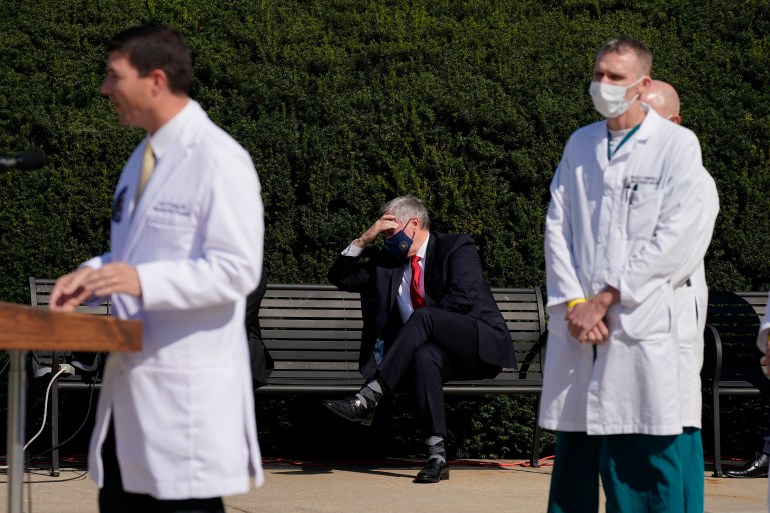
October 3, 11:49 ET – Trump is improving but next seven to 10 days are ‘critical’, doctor tells media at Walter Reed
“At this time, the team and I are extremely happy with the progress the president has made. Thursday he had a mild cough, and some nasal congestion, and fatigue, all of which are now resolving and improving,” Dr Sean Conley said.
“Just 72 hours into the diagnosis now, the first week of COVID, and in particular day seven to 10 are the most critical in determining the likely course of this illness,” Conley said.
“I’d rather not give any specific numbers, but he did have a fever Thursday into Friday. Since Friday morning, he’s had none,” Conley told reporters.
Doctors said Trump began his first dose of remdesivir, an antiviral medication delivered via injection, the night before.
Conley did not inform the media that Trump had been administered oxygen previously. He would only say: “He’s not on oxygen right now.”
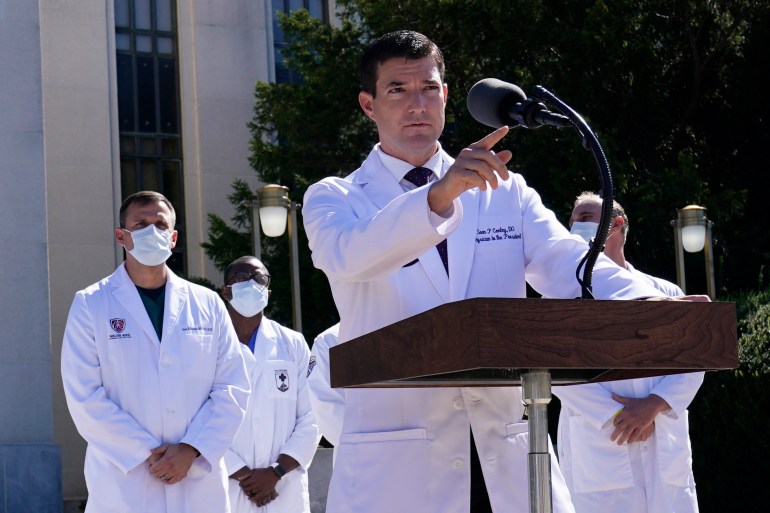
October 2, 23:47 ET – Doctor reports Trump is receiving remdesivir and ‘doing very well’
In a statement released by the White House, Dr Sean Conley said Trump “is not requiring any supplemental oxygen, but in consultation with specialists we have elected to initiate remdesivir therapy”.
“He has completed his first dose and is resting comfortably,” Conley said.
October 2, 18:31 ET – Trump posts short video message to Twitter saying he will be going to Walter Reed hospital
— Donald J. Trump (@realDonaldTrump) October 2, 2020
October 2, 18:16 ET – Trump emerges from the White House and walks to Marine One helicopter for a short flight to Walter Reed hospital
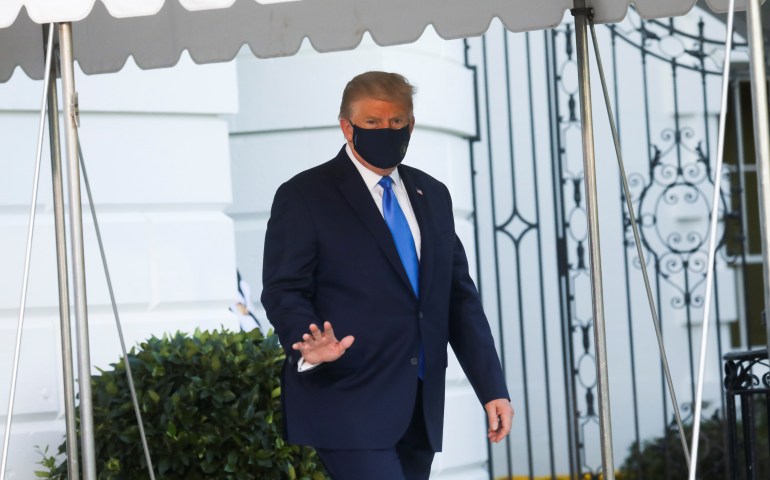
October 2, 16:15 ET – Trump receives Regeneron antibody cocktail, White House physician recommends he move to Walter Reed hospital
“Following PCR-confirmation of the president’s diagnosis, as a precautionary measure he received a single 8-gram dose of Regeneron’s polyclonal antibody cocktail,” White House physician Dr Sean Conley said in a statement.
“In addition to the polyclonal antibodies, the president has been taking zinc, vitamin D, famotidine, melatonin and a daily aspirin,” Conley said.
October 2, 00:54 ET Trump announced on Twitter that he and first lady Melania Trump had contracted the coronavirus
Tonight, @FLOTUS and I tested positive for COVID-19. We will begin our quarantine and recovery process immediately. We will get through this TOGETHER!
— Donald J. Trump (@realDonaldTrump) October 2, 2020
October 1 evening – Trump reportedly tests positive for COVID-19 before doing a telephone interview on Fox News – according to the Wall Street Journal
Trump speaks by telephone with Fox News host Sean Hannity about aide Hope Hicks testing positive for COVID-19.
“I’ll get my test back either tonight or tomorrow,” Trump said.
The Wall Street Journal, citing White House protocols, said the deep nasal test is only performed after a rapid test has indicated a positive reading, suggesting the president had already received a positive COVID-19 result.
Trump did not disclose a first positive test on the air. A second test later that night confirmed the result.
Earlier in the day, Trump had participated in a round-table discussion and fundraising event with about 200 supporters at his Bedminister, New Jersey, golf club.
September 26 – Trump nominates Amy Coney Barrett to the US Supreme Court in White House ceremony
At least 11 of 200 who attended the mostly maskless events, held both indoors and outdoors, including the president and people close to him, have tested positive for COVID-19.
